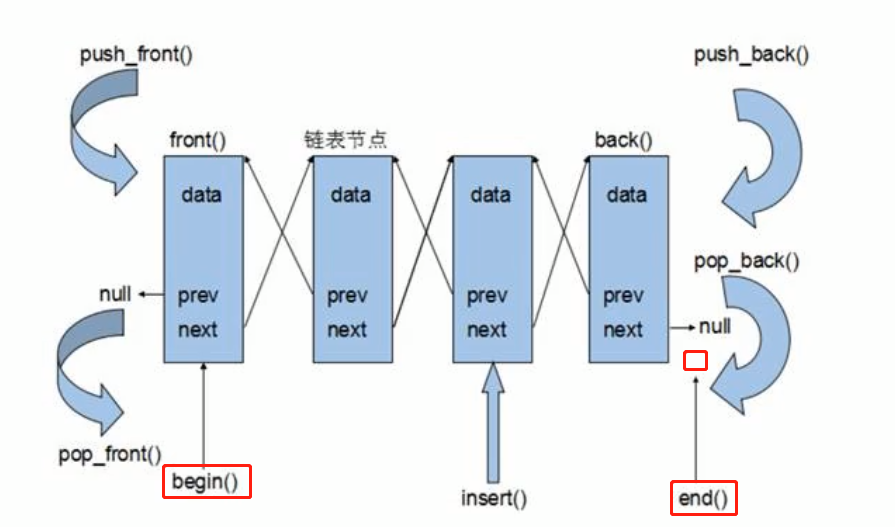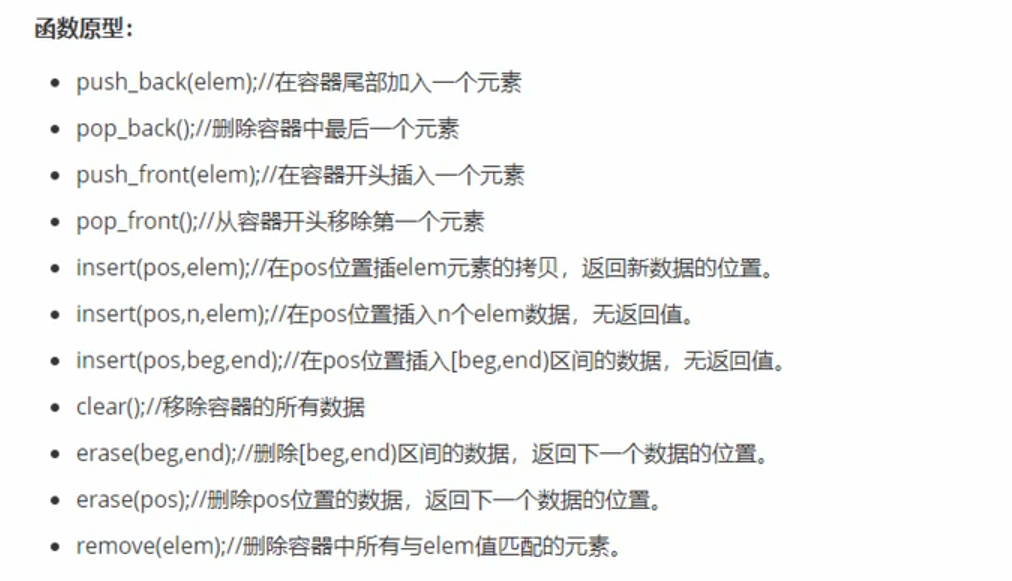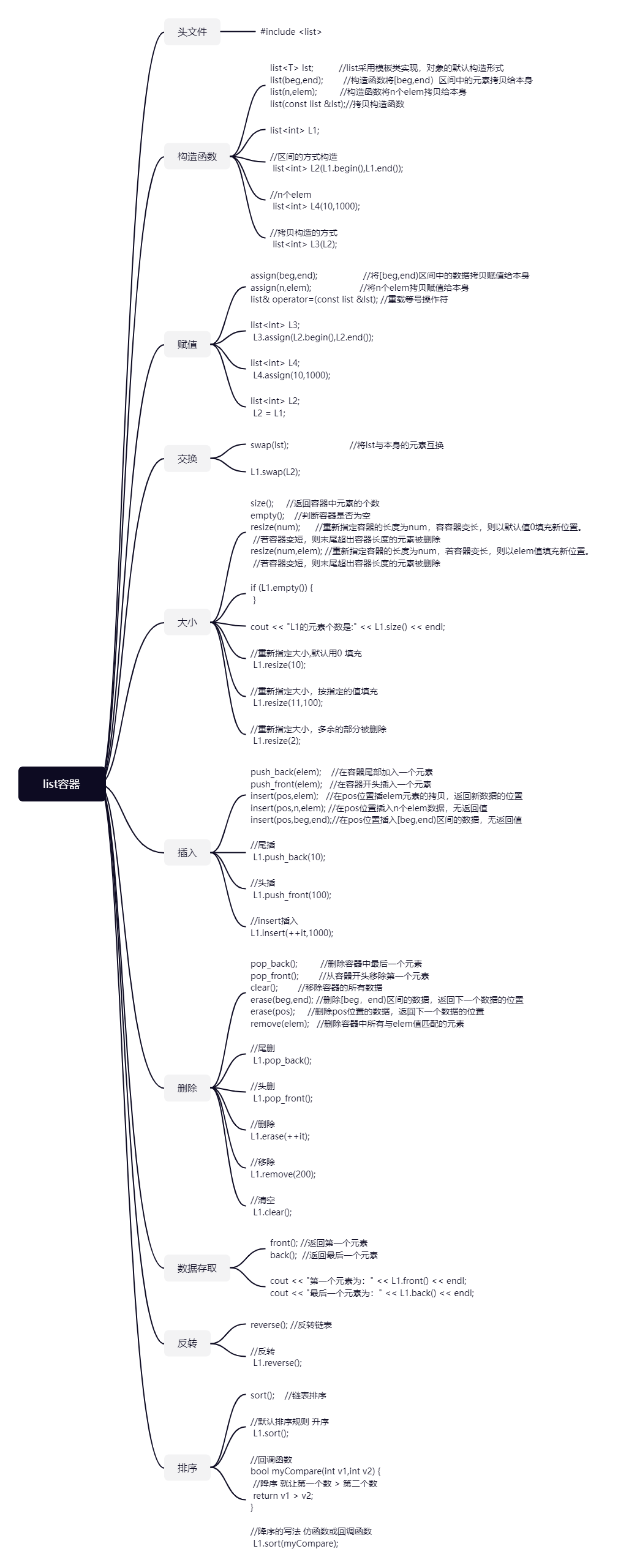C++学习 --- STL常用容器之list容器
6.1、list基本概念
功能:将数据进行链式存储
链表(list)是一种物理存储单元上非连续的存储结构,数据元素的逻辑顺序是通过链表中的指针链接实现的 。
链表的组成:链表由一些列节点组成
节点的组成:是一个存储数据元素的数据域,另一个是存储下一个节点地址的指针域。
优点:可以对任意位置进行快速插入和删除元素。不需要移动大量元素。
采用动态存储分配,不会造成内存浪费和溢出。
缺点:容器的遍历速度(不能跳跃访问)没有数组快。时间耗费比较大。
占用的空间(数据域和指针域)比数组大。
STL中的链表是一个双向循环链表。

由于链表的存储方式并不是连续的内存空间,因此链表list中的迭代器只支持前移和后移,属于双向迭代器。
List 重要性质,插入操作和删除操作都不会造成原有list迭代器的失效,这在vector是不成立的。(vector 一旦内存不够,需要重新开辟新的空间,迭代器的位置将改变)
STL中List和vector是两个最常被使用的容器,各有优缺点。
6.2、list构造函数
功能描述:
-
创建list容器
函数原型:
-
list<T> lst; //list采用模板类实现,对象的默认构造形式
-
list(beg,end); //构造函数将[beg,end)区间中的元素拷贝给本身
-
list(n,elem); //构造函数将n个elem拷贝给本身
-
list(const list &lst);//拷贝构造函数
#include <iostream> #include <list> using namespace std; /* list<T> lst; //list采用模板类实现,对象的默认构造形式 list(beg,end); //构造函数将[beg,end)区间中的元素拷贝给本身 list(n,elem); //构造函数将n个elem拷贝给本身 list(const list &lst);//拷贝构造函数 */ //list 容器构造函数 void printList(const list<int> &L) { for (list<int>::const_iterator it = L.begin(); it != L.end(); it++) { cout << *it << " "; } cout << endl; } void test01() { //创建list容器 list<int> L1; //添加数据 L1.push_back(10); L1.push_back(20); L1.push_back(30); L1.push_back(40); //遍历容器 printList(L1); //区间的方式构造 list<int> L2(L1.begin(),L1.end()); printList(L2); //拷贝构造的方式 list<int> L3(L2); printList(L3); //n个elem list<int> L4(10,1000); printList(L4); } int main() { test01(); system("pause"); return 0; }
总结:list构造方式同其他几个STL常用容器基本一样
6.3、list赋值和交换
功能描述:
-
给list容器进行赋值,以及交换list容器
函数原型:
-
assign(beg,end); //将[beg,end)区间中的数据拷贝赋值给本身
-
assign(n,elem); //将n个elem拷贝赋值给本身
-
list& operator=(const list &lst); //重载等号操作符 swap(lst); //将lst与本身的元素互换
#include <iostream> #include <list> using namespace std; /* assign(beg,end); //将[beg,end)区间中的数据拷贝赋值给本身 assign(n,elem); //将n个elem拷贝赋值给本身 list& operator=(const list &lst); //重载等号操作符 swap(lst); //将lst与本身的元素互换 */ void printList(const list<int> &L) { for (list<int>::const_iterator it = L.begin(); it != L.end(); it++) { cout << *it << " "; } cout << endl; } void test01() { list<int> L1; L1.push_back(10); L1.push_back(20); L1.push_back(30); L1.push_back(40); printList(L1); list<int> L2; L2 = L1; printList(L2); list<int> L3; L3.assign(L2.begin(),L2.end()); printList(L3); list<int> L4; L4.assign(10,1000); printList(L4); } //交换 void test02() { list<int> L1; L1.push_back(10); L1.push_back(20); L1.push_back(30); L1.push_back(40); list<int> L2; L2.assign(10, 100); cout << "交换前:" << endl; printList(L1); printList(L2); L1.swap(L2); cout << "交换后:" << endl; printList(L1); printList(L2); } int main() { test01(); test02(); system("pause"); return 0; }
6.4、list大小操作

#include <iostream> #include <list> using namespace std; /* size(); //返回容器中元素的个数 empty(); //判断容器是否为空 resize(num); //重新指定容器的长度为num,容容器变长,则以默认值0填充新位置。 //若容器变短,则末尾超出容器长度的元素被删除 resize(num,elem); //重新指定容器的长度为num,若容器变长,则以elem值填充新位置。 //若容器变短,则末尾超出容器长度的元素被删除 */ void printList(const list<int> &L) { for (list<int>::const_iterator it = L.begin(); it != L.end(); it++) { cout << *it << " "; } cout << endl; } void test01() { list<int> L1; L1.push_back(10); L1.push_back(20); L1.push_back(30); L1.push_back(40); printList(L1); //判断容器是否为空 if (L1.empty()) { cout << "L1为空" << endl; } else { cout << "L1不为空" << endl; cout << "L1的元素个数是:" << L1.size() << endl; } //重新指定大小,默认用0 填充 L1.resize(10); printList(L1); //重新指定大小,按指定的值填充 L1.resize(11,100); printList(L1); //重新指定大小,多余的部分被删除 L1.resize(2); printList(L1); } int main() { test01(); system("pause"); return 0; }
6.5、list插入和删除

#include <iostream> #include <list> using namespace std; /* push_back(elem); //在容器尾部加入一个元素 pop_back(); //删除容器中最后一个元素 push_front(elem); //在容器开头插入一个元素 pop_front(); //从容器开头移除第一个元素 insert(pos,elem); //在pos位置插elem元素的拷贝,返回新数据的位置 insert(pos,n,elem); //在pos位置插入n个elem数据,无返回值 insert(pos,beg,end);//在pos位置插入[beg,end)区间的数据,无返回值 clear(); //移除容器的所有数据 erase(beg,end); //删除[beg,end)区间的数据,返回下一个数据的位置 erase(pos); //删除pos位置的数据,返回下一个数据的位置 remove(elem); //删除容器中所有与elem值匹配的元素 */ void printList(const list<int> &L) { for (list<int>::const_iterator it = L.begin(); it != L.end(); it++) { cout << *it << " "; } cout << endl; } void test01() { list<int> L1; //尾插 L1.push_back(10); L1.push_back(20); L1.push_back(30); //头插 L1.push_front(100); L1.push_front(200); L1.push_front(300); //300 200 100 10 20 30 printList(L1); //尾删 L1.pop_back(); //300 200 100 10 20 printList(L1); //头删 L1.pop_front(); //200 100 10 20 printList(L1); //insert插入 list<int>::iterator it = L1.begin(); L1.insert(++it,1000); // 200 1000 100 10 20 printList(L1); //删除 it = L1.begin(); L1.erase(++it); // 200 100 10 20 printList(L1); //移除 L1.push_back(200); //200 100 10 20 200 printList(L1); L1.remove(200); //100 10 20 printList(L1); //清空 L1.clear(); printList(L1); } int main() { test01(); system("pause"); return 0; }
6.6、list数据存取

list 不一定是用连续的线性空间存储数据,所以不能用at和 []的方式访问容器中的元素。
迭代器也不支持随机(跳跃式 it = it+1)访问,可以移动(it++,it--)访问。
#include <iostream> #include <list> using namespace std; /* front(); //返回第一个元素 back(); //返回最后一个元素 */ //list容器中的数据存取 void printList(const list<int> &L) { for (list<int>::const_iterator it = L.begin(); it != L.end(); it++) { cout << *it << " "; } cout << endl; } void test01() { list<int> L1; //尾插 L1.push_back(10); L1.push_back(20); L1.push_back(30); L1.push_back(40); cout << "第一个元素为:" << L1.front() << endl; cout << "最后一个元素为:" << L1.back() << endl; //L1[0] 不可以用[]访问list容器中的元素 //L1.at(0) 不可以用at的方式访问list容器中的元素 //原因是list本质链表,不是用连续性空间存储数据,迭代器也是不支持随机访问的 //验证迭代器是不支持随机访问的 list<int>::iterator it = L1.begin(); //支持双向 it++; //向后 it--; //向前 //it = it + 1; //不支持随机访问 } int main() { test01(); system("pause"); return 0; }
6.7、list反转和排序

#include <iostream> #include <list> using namespace std; /* reverse(); //反转链表 sort(); //链表排序 */ //list反转和排序 void printList(const list<int> &L) { for (list<int>::const_iterator it = L.begin(); it != L.end(); it++) { cout << *it << " "; } cout << endl; } void test01() { list<int> L1; //尾插 L1.push_back(10); L1.push_back(20); L1.push_back(30); L1.push_back(40); printList(L1); //反转 L1.reverse(); printList(L1); } //回调函数 bool myCompare(int v1,int v2) { //降序 就让第一个数 > 第二个数 return v1 > v2; } void test02() { list<int> L1; //尾插 L1.push_back(40); L1.push_back(80); L1.push_back(30); L1.push_back(10); //排序 cout << "排序前:" << endl; printList(L1); //所有不支持随机访问迭代器的容器不支持用标准算法 //sort(L1.begin(),L1.end()); //而容器内部会提供相应的算法 //默认排序规则 升序 L1.sort(); cout << "排序后:" << endl; printList(L1); //降序的写法 仿函数或回调函数 L1.sort(myCompare); printList(L1); } int main() { test01(); test02(); system("pause"); return 0; }
6.8、排序案例

#include <list> #include <string> #include <iostream> using namespace std; /* list 容器 排序案例 对于自定义数据类型 做排序 按照年龄进行升序,如果年龄相同按照身高进行降序 */ class Person { public: Person(string name, int age, int height) { this->m_Name = name; this->m_Age = age; this->m_Height = height; } string m_Name;//姓名 int m_Age;//年龄 int m_Height; //身高 }; void ptintList(const list<Person> &L) { for (list<Person>::const_iterator it = L.begin(); it != L.end(); it++) { cout << "姓名:" << it->m_Name << " 年龄:" << it->m_Age << " 身高:" << it->m_Height << endl; } } //回调函数,指定排序规则 bool comparePerson(Person &p1,Person &p2) { //年龄相同 if (p1.m_Age == p2.m_Age) //按照身高降序 return p1.m_Height > p2.m_Height; else return p1.m_Age < p2.m_Age; } void test01() { list<Person> L; //准备数据 Person p1("刘备",35,175); Person p2("曹操",45,180); Person p3("孙权",45,170); Person p4("赵云",25,190); Person p5("张飞",35,160); Person p6("关羽",35,200); //尾插 L.push_back(p1); L.push_back(p2); L.push_back(p3); L.push_back(p4); L.push_back(p5); L.push_back(p6); ptintList(L); //排序后 cout << endl << "排序后:" << endl; //自定义数据类型排序需要指定规则,写回调函数或者是仿函数 L.sort(comparePerson); ptintList(L); } int main() { test01(); system("pause"); return 0; }




